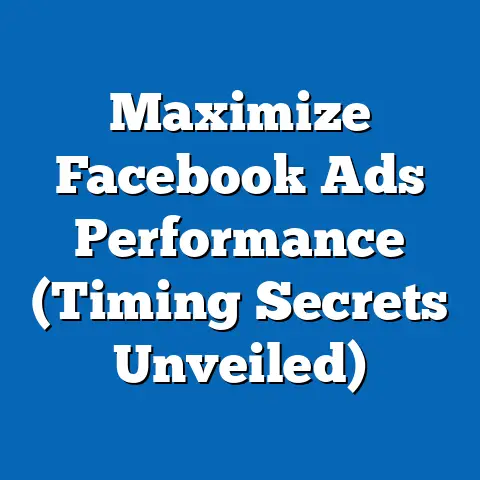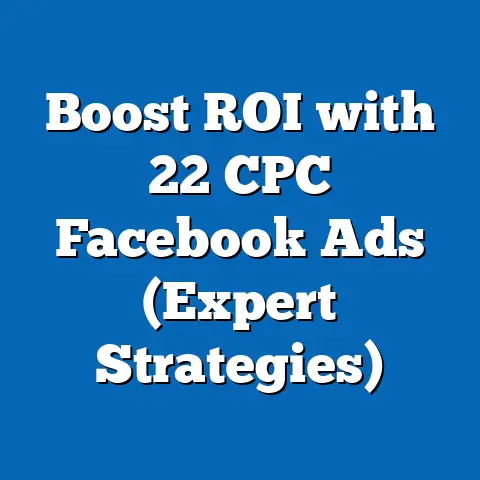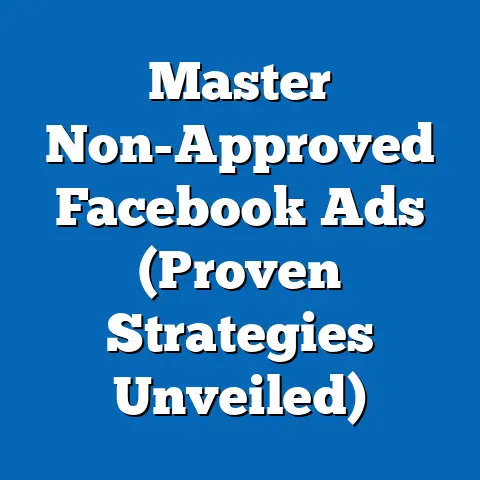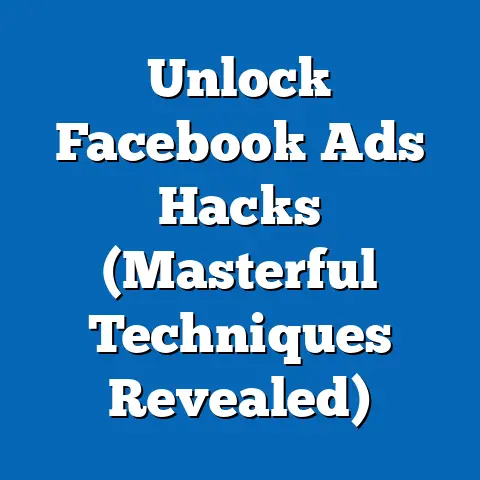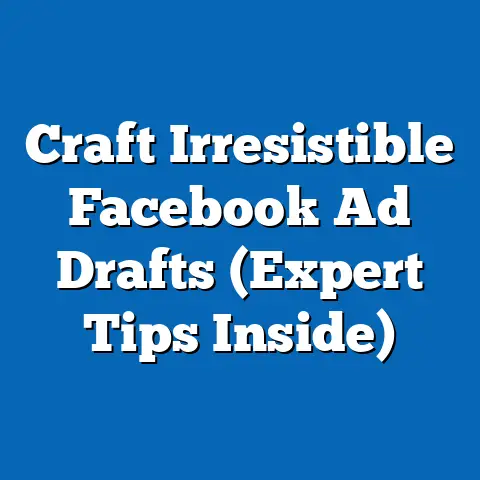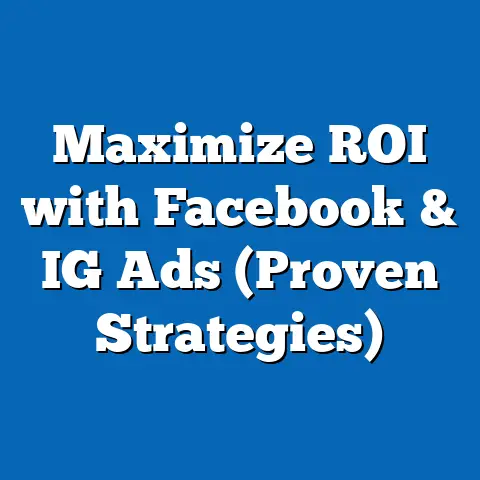Boost In-Store Sales with Facebook Ads (Proven Strategies)
Have you ever felt a wave of warmth wash over you when you saw a classic advertisement from your childhood? That’s the power of nostalgia, and it’s a potent force in marketing. I’ve seen firsthand how tapping into these feelings can create a powerful connection with potential customers. In today’s digital world, Facebook ads provide an incredible opportunity to harness that nostalgia and drive real-world, in-store sales.
This article isn’t just about running Facebook ads; it’s about strategically crafting campaigns that resonate with your audience on an emotional level, ultimately leading them to walk through your doors and make a purchase. I’m going to share proven strategies, from setting up your campaigns to crafting compelling content and measuring your success. Get ready to learn how to transform your Facebook ads into a powerful tool for boosting your brick-and-mortar business.
1. Understanding the Power of Nostalgia in Marketing
Nostalgia marketing is more than just throwing up old logos or vintage fonts. It’s a strategic approach that leverages the positive associations people have with the past to connect with them in the present. It’s about tapping into those cherished memories and feelings to create a sense of familiarity, comfort, and even excitement.
What is Nostalgia Marketing?
Simply put, nostalgia marketing is a strategy that evokes feelings of the past in consumers, often through imagery, themes, or references to popular culture from a specific era. Think about it: a commercial featuring a classic car, a slogan from the 80s, or even just a specific color palette can instantly transport you back to a different time.
But why does it work? Psychologically, nostalgia serves as a comforting balm, especially during times of uncertainty or change. It provides a sense of continuity and belonging, reminding us of simpler times and positive experiences. This feeling translates into increased trust and engagement with brands that can effectively tap into these emotions.
Brands That Do Nostalgia Right
I’ve seen countless brands try to leverage nostalgia, but some truly nail it. Let’s look at a few examples:
- Coca-Cola: They are masters of nostalgia. Their holiday ads featuring the iconic polar bears have been a staple for decades, instantly triggering feelings of warmth, family, and tradition. They also frequently bring back classic bottle designs and slogans, reminding us of simpler times.
- Nintendo: The re-release of classic consoles like the NES and SNES Classic was a stroke of genius. They tapped into the childhood memories of millions, creating a frenzy of demand and driving significant sales. It wasn’t just about the games; it was about reliving a cherished part of their lives.
- Burger King: Burger King has often used nostalgia in their marketing campaigns, whether through the return of the King mascot or by reintroducing classic menu items. These strategies evoke memories of past experiences with the brand, enticing customers to revisit their restaurants.
These examples demonstrate that successful nostalgia marketing isn’t just about showcasing old products; it’s about creating a feeling, telling a story, and connecting with your audience on an emotional level. I have seen how many companies can use nostalgia to market to new clients.
Creating Familiarity, Trust, and Emotional Connection
The power of nostalgia lies in its ability to bypass the rational mind and go straight to the heart. When you evoke a positive memory, you’re not just selling a product; you’re selling an experience, a feeling, a connection.
- Familiarity: Nostalgic elements create instant recognition and a sense of comfort. People are naturally drawn to things they recognize and associate with positive experiences.
- Trust: By tapping into shared memories, you build trust with your audience. They see your brand as relatable and authentic, rather than just another faceless corporation.
- Emotional Connection: Nostalgia creates a powerful emotional bond. People are more likely to engage with brands that make them feel something, and those feelings often translate into increased brand loyalty and purchasing behavior.
Who is Most Influenced by Nostalgia?
While nostalgia can be effective across demographics, certain groups are particularly susceptible:
- Millennials: Growing up in the 80s and 90s, Millennials are a prime target for nostalgia marketing. They have strong emotional connections to the music, movies, and fashion of that era.
- Gen X: Having experienced the cultural shifts of the late 20th century, Gen Xers often respond positively to brands that remind them of their youth.
- Parents: Parents often seek to share nostalgic experiences with their children, introducing them to the things they loved growing up. This creates a unique opportunity for brands to connect with multiple generations.
Understanding your target audience and the specific eras they associate with positive memories is crucial for crafting effective nostalgia-driven Facebook ad campaigns.
Takeaway: Nostalgia marketing is a powerful tool for creating emotional connections with your audience, building trust, and driving engagement. By understanding the psychological effects of nostalgia and targeting the right demographics, you can craft Facebook ad campaigns that resonate with your audience on a deeper level.
2. Setting Up Your Facebook Ads for In-Store Sales
Okay, so you’re ready to tap into the power of nostalgia to drive in-store sales. That’s fantastic! But before you start creating your ads, it’s crucial to understand how to set them up for maximum impact. I’ve seen many businesses fail because they skip this important step.
Choosing the Right Facebook Ad Format
Facebook offers a variety of ad formats, each with its own strengths and weaknesses. For brick-and-mortar businesses aiming to drive in-store sales, some formats are particularly effective:
- Carousel Ads: These ads allow you to showcase multiple products or features in a single ad unit. For example, a clothing store could use a carousel ad to highlight different outfits, each with a nostalgic theme. The ability to tell a story across multiple images or videos makes carousel ads highly engaging.
- Video Ads: Video is king when it comes to grabbing attention. A well-produced video can evoke powerful emotions and tell a compelling story. Consider creating a video that showcases your store’s atmosphere, highlights nostalgic products, or features customer testimonials.
- Slideshow Ads: These ads are a budget-friendly alternative to video ads. You can create a slideshow using existing images or stock photos, adding text overlays and music to create an engaging visual experience. Slideshow ads are great for showcasing a variety of products or highlighting different aspects of your store.
- Offer Ads: These ads are designed to promote special offers and discounts, encouraging customers to make a purchase. They can be particularly effective for driving in-store traffic by offering exclusive deals to Facebook users who visit your physical location.
Geo-Targeting: Reaching Customers Nearby
Geo-targeting is a game-changer for brick-and-mortar businesses. It allows you to target your ads to people who are physically located near your store. This is essential for driving in-store traffic, as you’re reaching people who are most likely to visit your location.
Here’s how it works:
- Location Targeting: You can target your ads to people who live in, recently visited, or are traveling in a specific geographic area.
- Radius Targeting: You can set a radius around your store and target your ads to people within that radius. For example, you could target people within a 5-mile radius of your store.
- Address-Based Targeting: You can upload a list of customer addresses and target your ads to those specific individuals.
By combining geo-targeting with nostalgic ad content, you can create highly effective campaigns that drive foot traffic and sales.
Step-by-Step Guide: Setting Up Your In-Store Sales Campaign
Okay, let’s get practical. Here’s a step-by-step guide to setting up a Facebook ad campaign aimed at driving in-store sales:
- Go to Facebook Ads Manager: Log in to your Facebook account and navigate to Ads Manager.
- Create a New Campaign: Click the “Create” button to start a new campaign.
- Choose Your Objective: Select the “Traffic” or “Store Traffic” objective. If you have a catalog, selecting “Sales” may also be a good option. The choice will depend on your specific goals and the types of ads you want to run.
- Name Your Campaign: Give your campaign a descriptive name that reflects its purpose.
- Set Your Budget: Determine your daily or lifetime budget. Start with a smaller budget and gradually increase it as you optimize your campaign.
- Define Your Audience: Use Facebook’s targeting options to define your ideal customer. Consider demographics, interests, behaviors, and location.
- Choose Your Ad Placement: Select where you want your ads to appear (e.g., Facebook feed, Instagram feed, Audience Network).
- Create Your Ad: Choose your ad format (carousel, video, slideshow, etc.) and create your ad content. Focus on evoking nostalgia and highlighting your store’s unique offerings.
- Add a Call to Action: Use a clear and compelling call to action, such as “Visit Our Store Today,” “Shop Now,” or “Get Directions.”
- Track Your Results: Use Facebook Ads Manager to track your campaign’s performance and make adjustments as needed.
The Importance of A/B Testing
A/B testing is crucial for identifying what resonates best with your audience. It involves creating multiple versions of your ad (with different headlines, images, or targeting options) and testing them against each other to see which performs best.
Here are some things you can A/B test:
- Headlines: Try different headlines to see which ones grab the most attention.
- Images: Test different images to see which ones evoke the strongest emotional response.
- Targeting Options: Experiment with different targeting options to see which ones reach the most relevant audience.
- Call to Actions: Try different call to actions to see which ones drive the most clicks.
By continuously A/B testing your ads, you can optimize your campaigns for maximum impact and drive more in-store sales.
Takeaway: Setting up your Facebook ads correctly is essential for driving in-store sales. By choosing the right ad format, leveraging geo-targeting, and A/B testing your ads, you can create highly effective campaigns that reach the right audience and drive foot traffic to your store.
3. Crafting Compelling Ad Content That Resonates
You’ve got your Facebook ad campaign set up, you’ve targeted your audience, now it’s time for the magic: crafting ad content that truly resonates. This is where the power of nostalgia comes into play. I have found many times, that I can create an emotional connection with my client’s customers.
Elements of Effective Ad Copy
Your ad copy is your chance to tell a story, evoke emotions, and persuade people to take action. Here are some key elements to consider:
- Evoke Nostalgia: Use language that triggers memories and feelings of the past. Refer to popular culture, historical events, or trends from a specific era.
- Highlight Unique Selling Points: What makes your store special? What unique products or experiences do you offer? Highlight these in your ad copy.
- Create a Sense of Urgency: Encourage people to visit your store now by creating a sense of urgency. Offer a limited-time discount, promote an upcoming event, or highlight a popular product that’s selling fast.
- Use a Clear Call to Action: Tell people exactly what you want them to do. Use a clear and compelling call to action, such as “Visit Our Store Today,” “Shop Now,” or “Get Directions.”
Visuals That Connect with Memories
Your visuals are just as important as your ad copy. They should be eye-catching, relevant, and evocative of the past.
- Imagery: Use images that connect with your audience’s memories. Consider using vintage photos, images of classic products, or photos that capture the atmosphere of a specific era.
- Colors: Use colors that evoke nostalgia. Certain color palettes are strongly associated with specific eras. For example, pastel colors are often associated with the 1950s, while neon colors are associated with the 1980s.
- Themes: Choose themes that resonate with your target audience. Consider using themes related to popular culture, historical events, or trends from a specific era.
I have seen how choosing the right colors can evoke a sense of nostalgia.
Storytelling Techniques for Emotional Engagement
Storytelling is a powerful tool for creating emotional engagement. Here are some storytelling techniques you can use in your Facebook ads:
- Share a Personal Story: Share a personal story about your store or your products. This helps to humanize your brand and create a connection with your audience.
- Highlight Customer Testimonials: Share customer testimonials that highlight the positive experiences people have had at your store. This builds trust and encourages others to visit.
- Create a Narrative: Create a narrative that connects with your audience’s emotions. Tell a story about a customer who found the perfect item at your store, or about a historical event that’s relevant to your brand.
Examples of Successful Ad Copy and Creative
Let’s look at some examples of successful ad copy and creative that have driven in-store sales:
4. Utilizing Facebook’s Advanced Targeting Features
You’ve created compelling ad content that tugs at the heartstrings, but it won’t matter if it doesn’t reach the right people. That’s where Facebook’s advanced targeting features come in. I’ve seen campaigns skyrocket simply by refining the audience.
Custom Audiences: Targeting Your Existing Customers
Custom Audiences allow you to target your ads to people who have already interacted with your business. This can include:
- Website Visitors: Target people who have visited your website.
- Email List Subscribers: Upload your email list to target your subscribers on Facebook.
- Customer List: Upload a list of customer names and phone numbers to target your existing customers.
- Facebook Page Engagers: Target people who have liked or interacted with your Facebook page.
By targeting your existing customers, you can remind them about your store, promote special offers, and encourage them to visit again.
Lookalike Audiences: Finding New Customers
Lookalike Audiences allow you to find new customers who are similar to your existing customers. Facebook analyzes the characteristics of your Custom Audience (e.g., demographics, interests, behaviors) and finds other people who share those characteristics.
This is a powerful tool for expanding your reach and finding new customers who are likely to be interested in your store.
Interest Targeting: Reaching People with Specific Interests
Interest Targeting allows you to target your ads to people who have expressed an interest in specific topics. This can include:
- Hobbies: Target people who are interested in vintage cars, retro fashion, or classic music.
- Brands: Target people who have liked or followed specific brands related to your store’s offerings.
- Events: Target people who have attended or expressed interest in specific events related to your store’s theme.
By targeting people with specific interests, you can reach a highly relevant audience who are more likely to be interested in your store.
Refining Targeting with Audience Insights
Facebook Audience Insights provides valuable data about your target audience, including their demographics, interests, behaviors, and purchase habits.
You can use this data to refine your targeting and reach the most relevant potential customers. For example, you might discover that your target audience is primarily women aged 35-54 who are interested in vintage fashion and live within a 10-mile radius of your store.
Retargeting: Staying Top-of-Mind
Retargeting involves showing ads to people who have previously interacted with your brand but haven’t yet made a purchase or visited your store.
This is a highly effective strategy for staying top-of-mind and encouraging people to take action. For example, you could retarget people who have visited your website but haven’t made a purchase, or people who have liked your Facebook page but haven’t visited your store.
Case Studies: Targeting Success Stories
- Local Bookstore: A local bookstore used Custom Audiences to target their email list subscribers with ads promoting upcoming author events. They saw a significant increase in event attendance and book sales.
- Retro Toy Store: A retro toy store used Lookalike Audiences to find new customers who were similar to their existing customers. They saw a significant increase in website traffic and in-store sales.
- Vintage Record Store: A vintage record store used Interest Targeting to target people who were interested in classic rock music. They saw a significant increase in Facebook page likes and in-store visits.
Takeaway: Facebook’s advanced targeting features are essential for reaching the right audience and maximizing the effectiveness of your ad campaigns. By using Custom Audiences, Lookalike Audiences, Interest Targeting, and Audience Insights, you can refine your targeting and reach the most relevant potential customers.
5. Measuring Success and Optimizing Your Campaigns
You’ve launched your nostalgic Facebook ad campaign, targeted your audience, and crafted compelling content. Now, the crucial question: is it working? Measuring your success and optimizing your campaigns based on data is paramount. I’ve seen too many businesses waste money by ignoring this step.
Key Performance Indicators (KPIs) to Track
To measure the effectiveness of your Facebook ad campaigns in driving in-store sales, you need to track the right Key Performance Indicators (KPIs). Here are some essential metrics:
- Reach: The number of unique people who saw your ad.
- Impressions: The number of times your ad was displayed.
- Click-Through Rate (CTR): The percentage of people who clicked on your ad after seeing it.
- Cost Per Click (CPC): The average cost you pay each time someone clicks on your ad.
- Website Traffic: The number of people who visited your website after clicking on your ad.
- In-Store Visits: The number of people who visited your store after seeing your ad. (This can be tracked using Facebook’s Store Visits objective, or by using a third-party tracking tool.)
- Conversion Rate: The percentage of people who made a purchase after visiting your store.
- Return on Ad Spend (ROAS): The amount of revenue you generated for every dollar you spent on advertising.
Using Facebook Ads Manager for Analysis
Facebook Ads Manager provides a wealth of data about your campaign performance. You can use this data to analyze your results, identify trends, and make informed decisions about how to optimize your campaigns.
- Campaign Overview: Get a high-level overview of your campaign performance, including reach, impressions, clicks, and cost.
- Ad Set Analysis: Analyze the performance of individual ad sets to see which targeting options are most effective.
- Ad Analysis: Analyze the performance of individual ads to see which creatives and ad copy are resonating best with your audience.
- Demographics: See the demographics of the people who are seeing and interacting with your ads.
- Placement Analysis: See where your ads are being displayed and how they are performing in different placements.
Strategies for Optimization
Based on the data you collect, you can optimize your campaigns in a variety of ways:
- Adjust Targeting: Refine your targeting options to reach a more relevant audience.
- Adjust Ad Spend: Increase or decrease your ad spend based on campaign performance.
- Optimize Ad Creative: Experiment with different headlines, images, and ad copy to see what resonates best with your audience.
- Optimize Call to Actions: Test different call to actions to see which ones drive the most clicks and in-store visits.
- A/B Testing: Continuously A/B test your ads to identify what works best and improve your results over time.
Real-World Examples of Iteration
- Local Coffee Shop: A local coffee shop initially targeted their ads to people within a 5-mile radius of their store. After analyzing their data, they discovered that most of their customers were coming from a specific neighborhood within that radius. They adjusted their targeting to focus on that neighborhood and saw a significant increase in in-store visits.
- Vintage Furniture Store: A vintage furniture store initially used generic images in their ads. After A/B testing different images, they discovered that images of their unique, one-of-a-kind pieces performed much better. They started using more of those images and saw a significant increase in click-through rates.
- Retro Arcade: A retro arcade initially used the call to action “Visit Our Arcade.” After testing different call to actions, they discovered that “Play Now” drove more clicks and in-store visits. They switched to using “Play Now” and saw a significant improvement in their results.
Takeaway: Measuring your success and optimizing your campaigns based on data is essential for maximizing your return on investment. By tracking the right KPIs, analyzing your results, and implementing optimization strategies, you can continuously improve your campaigns and drive more in-store sales.
6. Integrating Facebook Ads with In-Store Promotions
Creating synergy between your online advertising and your physical store is crucial for a seamless customer experience and maximized results. I’ve seen businesses double their impact by aligning their Facebook ads with in-store promotions.
Creating Synergy Between Online and Offline
- Consistent Messaging: Ensure that your messaging is consistent across all platforms. Use the same branding, tone, and key messages in your Facebook ads as you do in your in-store promotions.
- Promote In-Store Events: Use Facebook ads to promote upcoming in-store events, such as product launches, workshops, or live music performances.
- Highlight In-Store Promotions: Use Facebook ads to highlight special in-store promotions, such as discounts, sales, or limited-time offers.
- Offer Exclusive Deals: Offer exclusive deals to Facebook users who visit your store. This can be a great way to incentivize people to visit your location.
Ideas for Promotional Campaigns
- Flash Sales: Promote flash sales on Facebook and encourage people to visit your store to take advantage of the limited-time offers.
- Loyalty Programs: Use Facebook ads to promote your loyalty program and encourage people to sign up.
- Exclusive In-Store Events: Host exclusive in-store events for Facebook followers. This can be a great way to build community and reward your loyal customers.
- Themed Promotions: Create themed promotions that tie into your store’s brand and appeal to your target audience.
Benefits of Cross-Promotion with Local Businesses
Cross-promotion with local businesses can be a great way to expand your reach and create a stronger community presence.
- Partner with Complementary Businesses: Partner with businesses that offer complementary products or services. For example, a vintage clothing store could partner with a local hair salon or a retro diner.
- Offer Joint Promotions: Offer joint promotions to customers who visit both businesses. For example, a customer who spends $50 at the vintage clothing store could get a free milkshake at the retro diner.
- Promote Each Other on Social Media: Promote each other’s businesses on social media. This can be a great way to reach new customers and build brand awareness.
Success Stories of Integrated Campaigns
- Local Brewery: A local brewery partnered with a nearby restaurant to offer a “Beer and Burger” special. They promoted the special on Facebook and saw a significant increase in both brewery and restaurant traffic.
- Independent Bookstore: An independent bookstore partnered with a local coffee shop to offer a “Book and Coffee” deal. They promoted the deal on Facebook and saw a significant increase in both bookstore and coffee shop sales.
- Record Store: A record store teamed up with a local vintage clothing shop to host a “Retro Night” event. They promoted the event on Facebook and saw a significant turnout, with many people visiting both stores.
Takeaway: Integrating your Facebook ads with in-store promotions can significantly boost your results. By creating synergy between your online and offline efforts, you can create a seamless customer experience and maximize your return on investment.
Conclusion
Boosting in-store sales with Facebook ads is not just about running ads; it’s about crafting a strategic, emotionally resonant experience that drives foot traffic and ultimately, revenue. As I’ve walked you through, leveraging nostalgia, implementing effective targeting, and consistently measuring your results are key components of success.
Don’t be afraid to experiment! The beauty of Facebook advertising lies in its flexibility. Test different ad formats, targeting options, and creative elements to discover what works best for your unique audience.
The potential of Facebook ads to transform your in-store sales is immense. Embrace these proven strategies, stay adaptable, and watch as your brick-and-mortar business thrives in the digital age. Now go out there and create some nostalgic magic!

